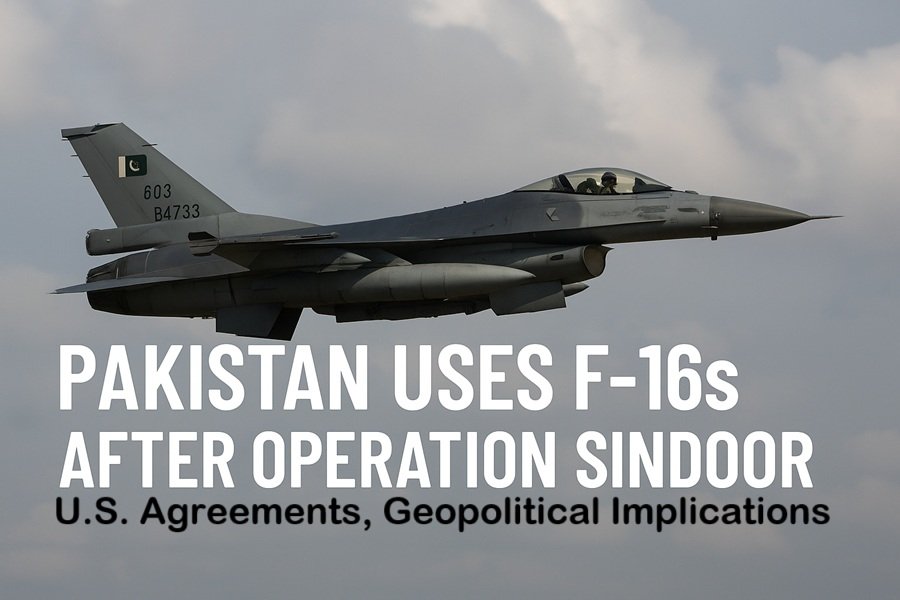
Introduction
The F-16 Fighting Falcon, a symbol of American air superiority, has long been at the heart of geopolitical tensions in South Asia. While the United States officially supports Pakistan’s F-16 fleet for counterterrorism purposes, recent developments — especially in the wake of India’s Operation Sindoor — reveal a complex and controversial reality. With Pakistan actively flying F-16s yesterday and today in response to Indian military posture, questions about end-use violations and strategic intent are once again under global scrutiny.
A Brief History of the U.S.-Pakistan F-16 Agreement
The Beginnings (1980s)
The F-16 journey began in the 1980s under the Reagan administration as part of Cold War-era cooperation. The U.S. sold 28 F-16A/B Block 15 aircraft to Pakistan to help it counter Soviet influence in Afghanistan.
Pressler Amendment Fallout (1990s)
The U.S. later halted deliveries due to Pakistan’s nuclear ambitions, citing the Pressler Amendment. Pakistan had paid for 28 more jets, but they were never delivered, leading to years of diplomatic strain.
Post-9/11 Reset and New Acquisitions (2000s)
After 9/11, Pakistan became a major non-NATO ally. The U.S. approved:
- 36 F-16C/D Block 52 aircraft
- Upgrades to existing F-16s
- Continued logistical and maintenance support
This was positioned as a move to boost counterterrorism capabilities — especially against Taliban elements near the Afghan border.
2022: U.S. Support Resumes Again
In a controversial move, the Biden administration approved a $450 million package for sustaining Pakistan’s F-16s, drawing immediate protests from India. The U.S. reiterated that these were:
“Intended to support Pakistan’s ability to meet current and future counterterrorism threats.“
Operation Sindoor and Renewed Tensions
What Was Operation Sindoor?
India’s recent Operation Sindoor, a high-precision airstrike against terror camps inside Pakistan-occupied Kashmir, marked a turning point in Indo-Pak military dynamics in 2025. The operation involved:
- Covert insertion of elite Indian Air Force (IAF) units
- Surgical strikes on identified terror hubs
- Swift withdrawal using Rafales and drones
Pakistan’s Response Using F-16s
In the immediate aftermath:
- Pakistan scrambled F-16 jets across multiple sectors bordering India.
- On May 7 and May 8, 2025, multiple sorties were recorded, including Combat Air Patrols (CAPs) by F-16s near the Sialkot, Bahawalpur, and Mirpur zones.
- These jets were fully armed, not for internal policing, but as a deterrent against perceived Indian escalation.
Despite no direct engagement, the air activity showcased that F-16s are Pakistan’s first-choice platform for frontline military signaling — not just counterinsurgency.
The Indian Viewpoint: “End-Use Clause Is a Joke”
India has repeatedly challenged the U.S. rationale behind providing F-16 support to Pakistan. Key objections include:
- 2019 Balakot Clashes: F-16s were used in air-to-air combat. India claims to have shot one down using a MiG-21 Bison, though the U.S. denied this.
- Post-Sindoor Activity: Pakistan’s continued use of F-16s against India shows that they are not restricted to counterterrorism.
Indian defense analysts argue:
“Terrorists don’t fly in formation at 30,000 feet. Pakistan is clearly using U.S.-supplied F-16s as strategic leverage against India — not for fighting insurgents.”
U.S. Strategic Dilemma
The U.S. continues to walk a fine line:
- On one hand, it views Pakistan as important for counterterrorism and regional stability, especially with ongoing unrest in Afghanistan.
- On the other, it wants to deepen ties with India as a strategic partner in the Indo-Pacific.
This duality leads to a policy contradiction:
- Weapons and aircraft meant for anti-terror operations are being used to threaten a democratic ally like India.
Military and Diplomatic Fallout
For Pakistan:
- F-16s remain a prestige asset and core to their air dominance doctrine.
- They regularly conduct night sorties, readiness drills, and CAPs using F-16s near the LoC.
For India:
- India has lodged diplomatic protests with Washington.
- Indian Air Force is increasing Rafale patrols and deploying S-400 air defense systems in sensitive sectors.
For the U.S.:
- It faces increasing pressure from Indian and bipartisan U.S. lawmakers to re-examine end-use violations.
- There’s growing talk in Washington circles about adding stricter monitoring protocols, including real-time mission audits and transponder tagging.
Conclusion
The myth that Pakistan’s F-16s are exclusively for counterterrorism has been shattered. From the 2019 Balakot episode to the 2025 post-Sindoor maneuvers, Pakistan continues to use these U.S.-supplied jets as a tactical and strategic tool against India.
While the U.S. insists its assistance is conditional and monitored, reality on the ground suggests a misalignment between intent and execution. As Indo-U.S. ties deepen and India asserts its regional interests, the debate over Pakistan’s F-16 usage is bound to intensify — perhaps becoming a litmus test for future arms diplomacy in South Asia.







